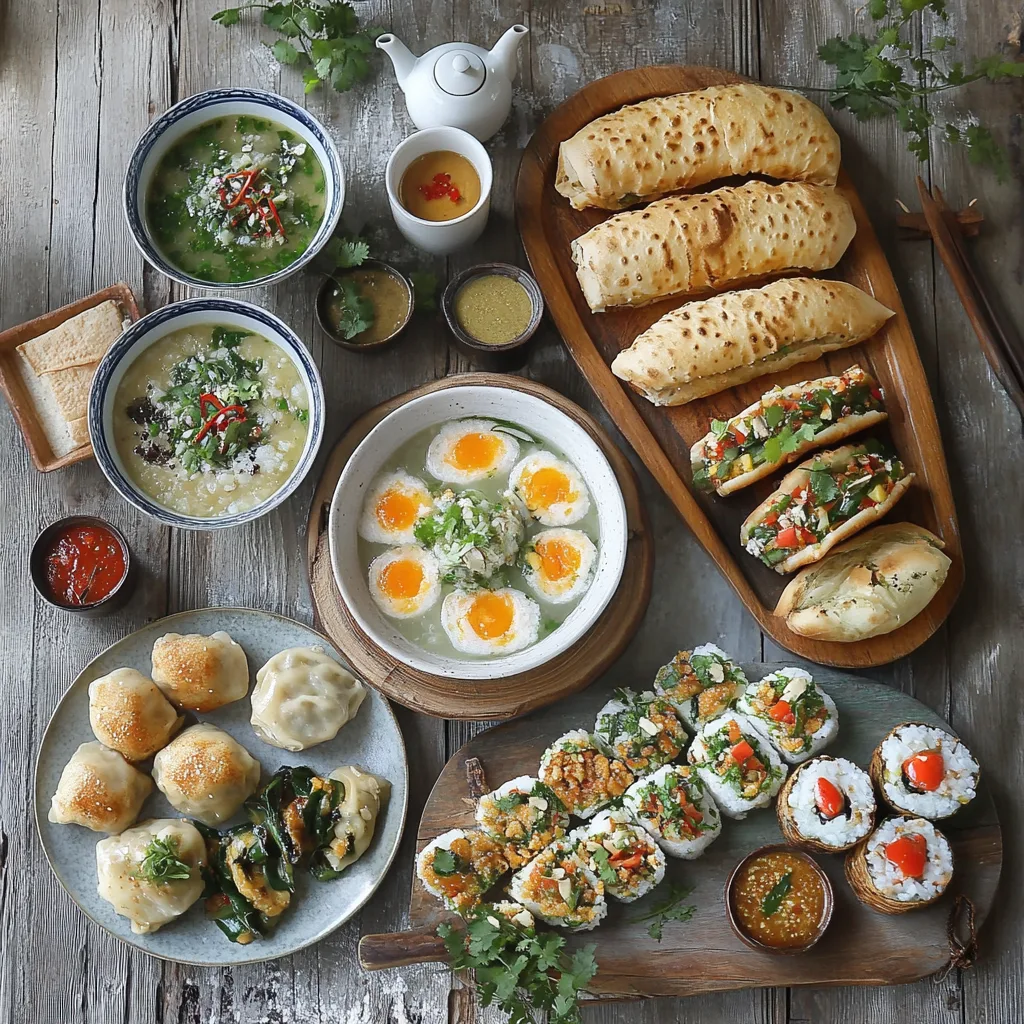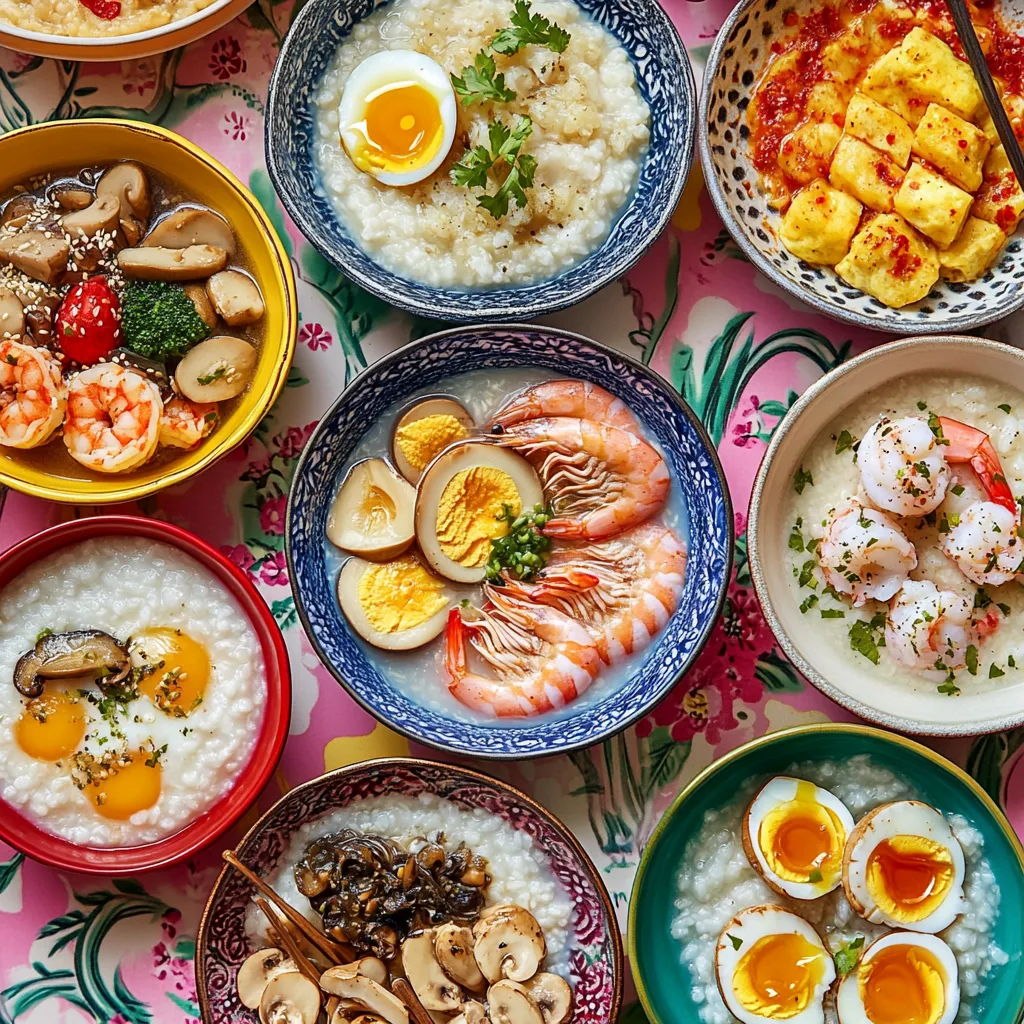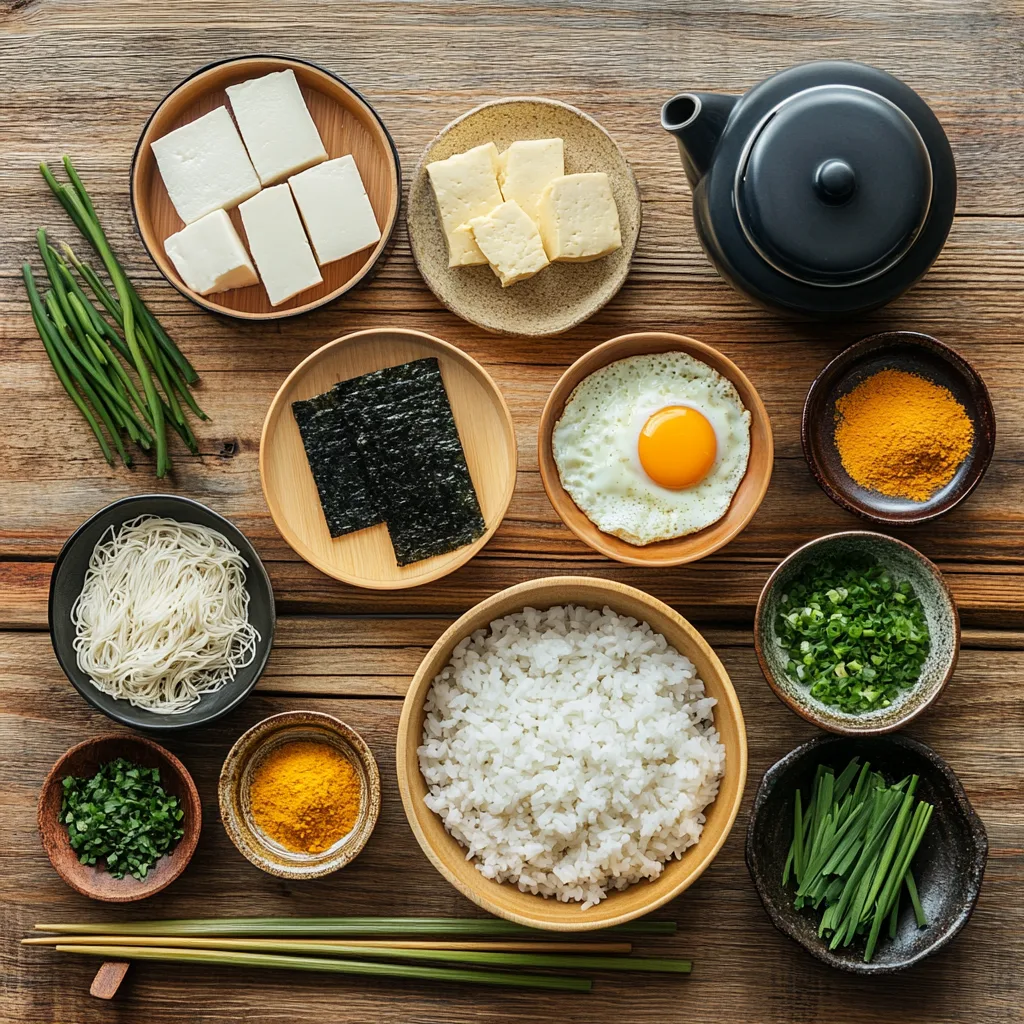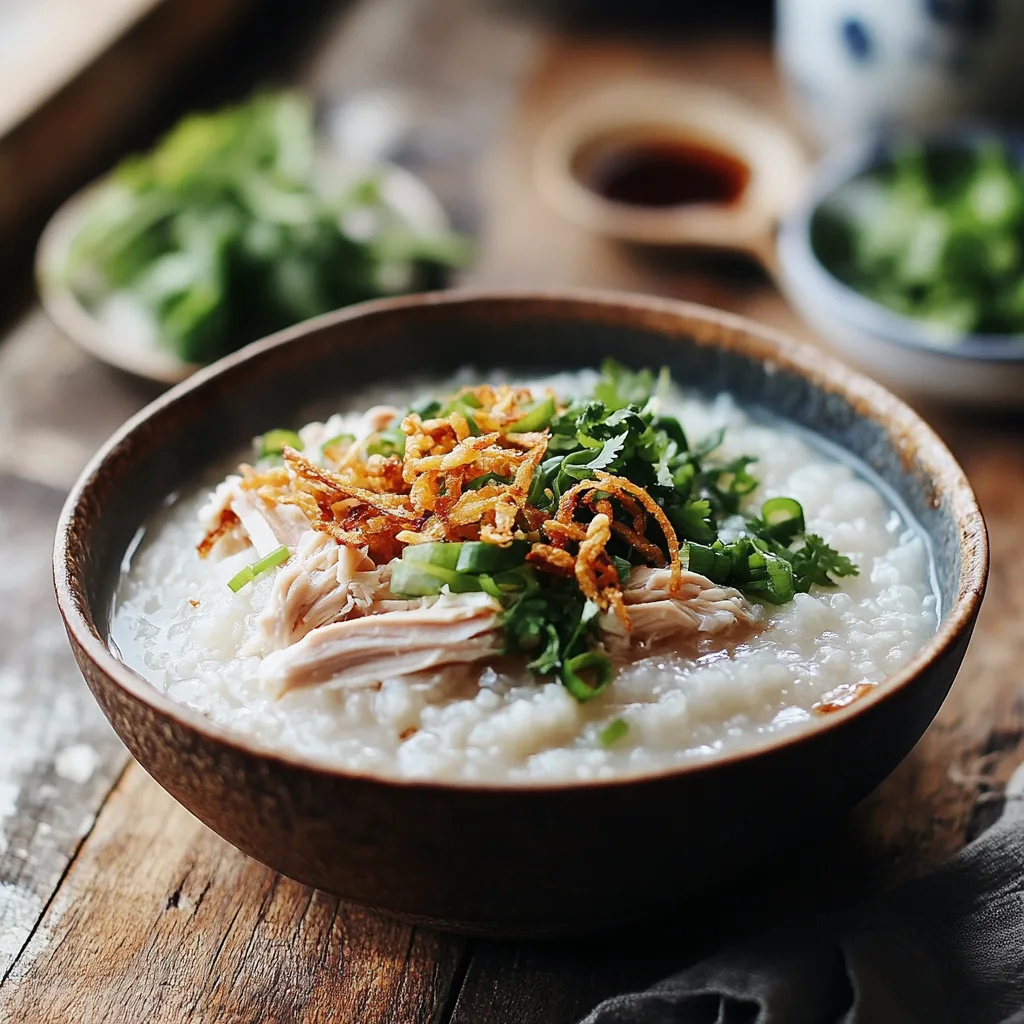Asian breakfasts are a treasure trove of flavors, colors, and cultural diversity. Each region offers a unique take on the most important meal of the day, with dishes ranging from comforting rice porridge to crispy breads and savory soups. Whether it’s the simplicity of a warm bowl of congee or the bold spices of halwa puri, these meals reflect the heart of their culinary traditions. In this guide, we’ll take a delicious journey through the essence of Asian breakfast, uncovering its regional varieties, health benefits, and how you can enjoy these dishes at home. Let’s begin with Part 1!
Introduction to Asian Breakfast
What Is an Asian Breakfast?
When you think about breakfast in Asia, it’s much more than just a quick bite to start the day. Across the continent, breakfast is deeply rooted in tradition and reflects the rich culinary history of each country. From savory to sweet, the dishes showcase a love for fresh ingredients and balanced flavors. Unlike the heavy, sugary breakfasts common in some parts of the world, Asian breakfasts are known for their ability to nourish both body and soul.
What makes them special? It’s the variety—think warm rice dishes, aromatic broths, soft breads, and even fermented foods that have been passed down through generations. In most Asian households, breakfast isn’t just about food—it’s an experience that brings families together and sets a positive tone for the day.
Why Is Asian Breakfast So Unique?
Let’s talk about why this meal stands out. First, it’s the use of local, fresh ingredients. Whether it’s fish, rice, or spices, everything is sourced from the region’s natural bounty. For example, in Japan, a bowl of miso soup or rice with pickled plums connects people to their roots. Meanwhile, India celebrates breakfast with spicy dosa or paratha paired with creamy chutneys.
Another key factor is the focus on balance. Many Asian breakfast dishes emphasize harmony between flavors—sweet, salty, sour, and umami—all in one plate. This approach not only satisfies your taste buds but also supports a healthy start to the day.
Finally, the traditions tied to breakfast rituals make it unique. In Korea, for instance, sitting down to a table filled with small, colorful banchan (side dishes) alongside your main meal symbolizes abundance. Similarly, the bustling streets of Vietnam come alive in the morning with vendors selling steaming bowls of pho and crispy banh mi.
So, why settle for the usual when the world of Asian breakfast offers such a feast for the senses? It’s about embracing variety and experiencing cultures through food.
Popular Asian Breakfast Dishes by Region
When it comes to Asian breakfast, the variety is staggering. From East Asia’s comforting bowls of rice to the bold, spicy flavors of South Asia, each region tells a story through its morning meals. Let’s journey across these diverse cuisines and uncover what makes each breakfast tradition so special.

East Asian Breakfasts
East Asia offers a mix of simplicity and sophistication. Its breakfast dishes often focus on light, nutritious meals that leave you feeling satisfied but not overly full.
- Japanese Breakfasts:
A traditional Japanese breakfast is a balanced spread of miso soup, steamed rice, grilled fish, and pickled vegetables. Sometimes, a raw egg is cracked over rice (known as tamago kake gohan) and mixed with soy sauce for a simple yet deeply satisfying dish. Onigiri, rice balls wrapped in seaweed, are another popular choice, often stuffed with fillings like salted plum or salmon. - Korean Breakfasts:
In Korea, breakfast is all about heartiness. A bowl of juk (rice porridge) is a common comfort food, served with various toppings like abalone or kimchi. Gimbap, the Korean cousin of sushi, is also enjoyed during mornings for its portability and flavor. On chillier days, a steaming bowl of soybean paste soup or kimchi stew warms both body and spirit. - Chinese Breakfasts:
China’s breakfast scene is as vast as the country itself. Dim sum is a favorite in the southern regions, featuring bite-sized dumplings, buns, and pastries served with tea. Congee (rice porridge) is a staple in many households, often topped with preserved eggs, pork floss, or scallions. On the streets, vendors sell crispy youtiao (fried dough sticks) paired with soy milk for a quick and satisfying meal.
Southeast Asian Breakfasts
Southeast Asia is a feast for the senses, and its breakfasts are no exception. From the aromatic herbs of Vietnam to the creamy rice dishes of Thailand, every bite is a burst of flavor.
- Thai Breakfasts:
In Thailand, jok (a rice porridge similar to congee) is commonly enjoyed in the mornings, often seasoned with garlic, ginger, and fresh cilantro. Another favorite is khao tom, a light rice soup served with vegetables and sometimes minced pork. Street food enthusiasts might also indulge in grilled skewers of chicken or pork alongside sticky rice. - Vietnamese Breakfasts:
A bowl of pho, with its rich, fragrant broth and fresh herbs, is a quintessential Vietnamese breakfast. Equally popular is banh mi, a French-inspired baguette stuffed with meats, pickled vegetables, and chili sauce. For a sweet start, many turn to xoi, a sticky rice dish that can be paired with mung beans, shredded coconut, or even grilled meat. - Indonesian Breakfasts:
Indonesia is known for its vibrant and hearty breakfast dishes. Nasi goreng, a flavorful fried rice dish, is often topped with a fried egg and served with prawn crackers. Bubur ayam, a chicken porridge garnished with peanuts, fried shallots, and sambal, is another comforting choice. And for a sweet bite, pisang goreng (fried bananas) is a favorite among locals.
South Asian Breakfasts
South Asia takes breakfast to another level with its bold spices and comforting carbs. Whether it’s flaky parathas or delicate idlis, these dishes offer a glimpse into the region’s culinary diversity.
- Indian Breakfasts:
India’s breakfast options are as diverse as its cultures. In the north, parathas stuffed with spiced potatoes or paneer are served with yogurt or pickles. Down south, you’ll find crispy dosas and fluffy idlis accompanied by coconut chutney and sambar, a tangy lentil soup. Another crowd favorite is poha, a lightly spiced flattened rice dish topped with peanuts and fresh coriander. - Pakistani Breakfasts:
In Pakistan, halwa puri reigns supreme. This indulgent combination of sweet semolina halwa, fried bread, and spiced chickpeas is a breakfast fit for celebrations. Nihari, a slow-cooked beef or lamb stew, is another beloved dish, often enjoyed with freshly baked naan. - Sri Lankan Breakfasts:
Sri Lanka’s breakfasts are a celebration of textures and flavors. String hoppers, delicate rice flour noodles, are served with coconut milk curry or dhal curry. Pol sambol, a spicy coconut relish, adds a zesty kick to every bite.
Middle Eastern Breakfasts (Western Asia)
The Middle Eastern region, often considered part of Asia, offers breakfasts rich in history and taste.
- Lebanese Breakfasts:
Manakish, a flatbread topped with za’atar or cheese, is a breakfast staple in Lebanon. Labneh, a tangy strained yogurt, is served with olive oil and warm pita bread for dipping. Foul medames, a dish of stewed fava beans, is another traditional choice, garnished with lemon juice, garlic, and fresh herbs. - Persian Breakfasts:
In Iran, mornings often begin with nan-e sangak, a sourdough flatbread baked on hot stones. It’s paired with butter, honey, or feta cheese. Halim, a slow-cooked wheat and meat porridge, is another common dish, perfect for colder mornings.
Nutritional Benefits of Asian Breakfasts
Breakfast is often called the most important meal of the day, and in Asia, it’s crafted not only to delight the taste buds but also to fuel the body. Many traditional Asian breakfasts prioritize balance, featuring a mix of carbohydrates, proteins, and vegetables. Let’s dig into the unique nutritional advantages these meals bring to the table.

Why Asian Breakfasts Are Often Healthier
The foundation of many Asian breakfast dishes is rooted in balance and natural ingredients. Unlike processed cereals or sugary pastries, these meals typically include whole foods that are minimally refined. For instance, rice-based breakfasts like congee or nasi goreng provide complex carbohydrates that release energy slowly throughout the day.
Another standout feature is the inclusion of fermented foods. Items like miso soup, kimchi, and pickled vegetables are often served with breakfast in countries like Japan, Korea, and China. These foods are rich in probiotics, which help support gut health and improve digestion. A healthy gut is the key to a strong immune system, so starting your day with fermented options offers a natural boost.
Furthermore, Asian breakfasts often incorporate vegetables even in the morning. Think of the fresh herbs and greens in pho or the cooked spinach and seaweed in a Japanese breakfast. These ingredients add fiber, vitamins, and minerals to the meal, helping you meet your daily nutritional needs right from the start.
Superfoods in Asian Breakfasts
Asian breakfasts are often packed with superfoods that provide multiple health benefits. Here are some common ones:
- Tofu: A staple in East Asia, tofu is high in protein and contains all nine essential amino acids. It’s also an excellent source of iron, calcium, and magnesium.
- Miso: This fermented soybean paste is not just for soup. Miso is rich in antioxidants and can support heart health and reduce inflammation.
- Ginger: Found in many Southeast Asian dishes, ginger is known for its anti-inflammatory and digestive properties.
- Sesame Seeds: Often used as a garnish or incorporated into sauces, sesame seeds are packed with calcium and healthy fats.
- Coconut: Whether it’s coconut milk in Sri Lankan curry or coconut chutney in South India, this ingredient provides a dose of healthy fats and electrolytes.
Including these nutrient-dense foods in breakfast can give you the energy to tackle your day and promote overall well-being.
Comparison with Other Breakfast Styles
One striking difference between Asian breakfasts and those in the West lies in the variety of flavors and nutritional profiles. Western breakfasts often rely heavily on sugar or processed foods, such as pancakes, muffins, or breakfast cereals. While these options might be quick and convenient, they often lead to energy crashes later in the day due to their high glycemic index.
In contrast, Asian breakfasts focus on slow-releasing carbohydrates and nutrient-packed ingredients. For instance, the broth-based soups commonly eaten in Vietnam or Thailand are low in calories yet rich in vitamins and minerals. Similarly, meals like parathas or dosa in South Asia are paired with protein-rich accompaniments like lentils or yogurt, creating a more balanced start to the day.
Moreover, Asian breakfasts often embrace mindfulness and portion control. Many dishes are designed to be filling but not overwhelming, leaving you energized without feeling sluggish.
How to Create Your Own Asian Breakfast at Home
Making an Asian breakfast at home might seem intimidating at first, but with a bit of preparation and the right ingredients, it’s surprisingly easy to recreate the flavors of Asia in your own kitchen. Whether you’re craving a comforting bowl of rice porridge or a light, savory soup, here’s how to get started.
Essential Ingredients to Stock
The key to creating authentic Asian breakfasts lies in having the right staples in your pantry. While ingredients vary depending on the specific cuisine, a few basics can go a long way in replicating the flavors:

- Rice and Noodles:
- Rice is a cornerstone of many Asian breakfasts, whether as plain steamed rice, congee, or fried rice.
- Noodles like vermicelli, rice noodles, or udon are perfect for dishes such as pho or stir-fried noodle bowls.
- Soy Sauce and Fish Sauce:
- These condiments are essential for seasoning and adding depth to dishes. Fish sauce, commonly used in Southeast Asian recipes, delivers a savory, umami kick.
- Spices and Aromatics:
- Garlic, ginger, chili peppers, and lemongrass are must-haves for creating rich, fragrant flavors.
- Curry powders and spice mixes, such as garam masala or za’atar, bring the bold taste of South Asia and the Middle East.
- Vegetables and Proteins:
- Fresh greens like spinach, bok choy, or cilantro work well as garnishes or side dishes.
- Proteins like eggs, tofu, and seafood, such as shrimp or fish, are versatile options.
- Coconut Milk and Sesame Oil:
- Coconut milk adds creaminess to curries and soups, while sesame oil provides a nutty aroma for stir-fries or dressings.
Basic Equipment You’ll Need
To replicate authentic textures and flavors, having the right tools can make your cooking process smoother:
- Wok: Perfect for stir-frying, sautéing, or steaming, a wok is a versatile addition to your kitchen. Its shape allows for even cooking at high heat.
- Bamboo Steamer: Essential for making dumplings, buns, or steamed vegetables, this tool preserves the delicate flavors and textures of food.
- Rice Cooker: A game-changer for preparing perfectly fluffy rice or porridge without constant monitoring.
- Knives and Mortar and Pestle: Good knives are critical for chopping vegetables and proteins, while a mortar and pestle help release the full aroma of spices and herbs.
Quick and Easy Asian Breakfast Recipes
You don’t need to spend hours in the kitchen to enjoy a satisfying Asian breakfast. These simple recipes are perfect for beginners and can be tailored to your taste:
- Congee with Toppings:
- Cook 1 cup of rice with 6 cups of water or chicken broth over low heat until it reaches a porridge-like consistency.
- Add toppings like shredded chicken, boiled eggs, scallions, and soy sauce for a hearty meal.
- Miso Soup:
- Dissolve 2 tablespoons of miso paste in 4 cups of hot water or dashi stock.
- Toss in cubes of tofu, seaweed, and thinly sliced scallions for a light, nourishing soup.
- Customizable Rice Bowls:
- Start with a base of steamed rice, then top it with sautéed vegetables, grilled meat, or a fried egg.
- Drizzle with soy sauce or sesame oil and sprinkle sesame seeds for added texture.
These recipes showcase the adaptability of Asian breakfasts. By mixing and matching ingredients, you can create dishes that cater to your preferences and dietary needs.
FAQs About Asian Breakfast
To address common queries, here are detailed answers to frequently asked questions about Asian breakfasts.
What Is a Typical Asian Breakfast?
A typical Asian breakfast varies by country but often includes a combination of rice, noodles, soups, or bread served with accompaniments. For example:
- In Southeast Asia, dishes like pho (Vietnam) or nasi goreng (Indonesia) are popular.
- In East Asia, congee or steamed buns dominate the morning table.
- South Asia enjoys parathas, idlis, or dosas paired with chutneys or curries.
Breakfast in Asia emphasizes fresh ingredients, balanced flavors, and a mix of textures.
What Is Japanese Main Breakfast?
The traditional Japanese breakfast is a harmonious and nutritious meal. It typically includes:
- Steamed rice: The core of the meal, often accompanied by pickled vegetables.
- Miso soup: A light and flavorful soup made with miso paste, tofu, and seaweed.
- Grilled fish: Often mackerel or salmon, served simply to highlight its natural flavor.
- Tamago (egg): Sometimes served as tamagoyaki (sweet rolled omelet).
Japanese breakfasts are designed to be light yet nourishing, reflecting their cultural emphasis on balance and simplicity.
What Is the Healthiest Chinese Breakfast?
For a healthy start, some of the best Chinese breakfast options include:
- Congee (Rice Porridge): This easily digestible dish can be topped with vegetables, lean meats, or tofu.
- Soy Milk with Whole-Grain Youtiao: When prepared with less oil, youtiao pairs wonderfully with unsweetened soy milk.
- Steamed Dumplings: Filled with vegetables or lean proteins, these are a light yet satisfying choice.
- Vegetable Baozi (Steamed Buns): These fluffy buns filled with greens and mushrooms offer a nutritious and portable option.
The healthiest choices are often steamed or lightly seasoned, focusing on natural flavors.
What Is a Traditional Breakfast?
A traditional breakfast, in the Asian context, refers to meals deeply rooted in the region’s culinary heritage and culture. Examples include:
- Dim Sum in southern China, featuring small dumplings and buns served with tea.
- Halwa Puri in Pakistan, a festive combination of fried bread, chickpeas, and sweet semolina.
- Idli and Sambar in South India, a dish of steamed rice cakes with lentil soup.
- Manakish in Lebanon, a flatbread topped with za’atar, cheese, or meat.
Each traditional breakfast reflects local ingredients, cooking techniques, and the community’s way of life.
Conclusion:
Nutritional Elements in Popular Asian Breakfast Dishes
Asian breakfasts are not only flavorful but also packed with essential nutrients that support a healthy start to the day. Below is a table showcasing the nutritional components of some popular dishes:
| Dish | Calories | Protein (g) | Carbs (g) | Fat (g) | Key Nutrients |
|---|---|---|---|---|---|
| Congee (Rice Porridge) | 150 | 3 | 30 | 1 | Vitamin B, Magnesium, Iron |
| Pho (Vietnamese Soup) | 350 | 20 | 45 | 5 | Protein, Vitamin C, Calcium |
| Dosa with Chutney | 200 | 5 | 35 | 4 | Fiber, Vitamin E, Antioxidants |
| Miso Soup | 50 | 4 | 5 | 1 | Probiotics, Vitamin K, Iodine |
| Nasi Goreng (Fried Rice) | 400 | 10 | 50 | 15 | Selenium, B Vitamins, Healthy Fats |
| Idli with Sambar | 180 | 6 | 28 | 2 | Fiber, Vitamin A, Potassium |
| Halwa Puri | 500 | 8 | 65 | 20 | Carbohydrates, Iron, Calcium |
| Gimbap (Korean Rolls) | 300 | 8 | 40 | 8 | Omega-3, Vitamin A, Phosphorus |
Key Observations
- Balanced Meals: Most Asian breakfasts incorporate a good mix of carbohydrates, protein, and healthy fats to keep you energized throughout the morning.
- Rich in Nutrients: From probiotics in miso soup to the antioxidants in chutneys, these dishes are packed with essential vitamins and minerals.
- Customizable Options: Toppings like vegetables, herbs, and lean meats can be added to many dishes, increasing their nutritional value.
This diversity in nutrition ensures that Asian breakfasts are not only satisfying but also beneficial for long-term health.

